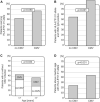The impact of NKG2A and NKG2D receptors and HLA-E and MICA ligands polymorphisms on post-transplant complications after paediatric allogeneic HSCT: a single-centre experience
- PMID: 37351346
- PMCID: PMC10282657
- DOI: 10.3389/fgene.2023.1186123
The impact of NKG2A and NKG2D receptors and HLA-E and MICA ligands polymorphisms on post-transplant complications after paediatric allogeneic HSCT: a single-centre experience
Abstract
Introduction: Natural Killer cells are the first subpopulation of lymphocytes that reconstitute after allogeneic haematopoietic stem cell transplantation (HSCT). Their activity is regulated by various receptor-ligand interactions, including stimulation of the activating NKG2D receptor by the MICA molecule, and inhibitory NKG2A receptor interacting with the HLA-E. In this study the research effort focused on the effect of selected NKG2A and NKG2D receptors and their ligands (HLA-E and MICA molecules) polymorphisms that may affect the pathomechanisms of post-transplant complications after HSCT in children. Methods: One hundred donor-recipient pairs from a single paediatric transplantation centre were investigated. Altogether six single nucleotide substitutions (NKG2A rs7301582; NKG2D rs1049174, rs1154831; HLA-E rs1264457; MICA rs1051792, rs1063635) were genotyped, and the influence of polymorphisms was analysed on acute and chronic graft-versus-host disease (GvHD), cytomegalovirus (CMV) infection incidence, disease relapse and survival. Results: The distribution of the evaluated polymorphisms did not differ between patients and their donors. The results showed a significant influence of HLA-E rs1264457 polymorphism in patients' HLA-E*01:01 allele, which was associated with increased risk of CMV infection (p = 0.050), especially in children positive for CMV IgG before transplantation (p = 0.001). Furthermore, the effect of HLA-E*01:01 allele on CMV infections was more evident in children above the age of 7 years (p = 0.031). Strong tendencies (0.05 < p < 0.10) towards association with the risk of acute GvHD were also observed for the NKG2A or MICA polymorphisms of the recipients. In addition, NKG2D rs1154831 AA and MICA rs1063635 GG might play a protective role as they were not present in any recipient who died after transplantation. Conclusion: In summary, there is emerging evidence that genotyping results of NKG2 receptors and their ligands, may have prognostic value for the outcome of paediatric allogeneic HSCT, but more extensive studies performed on larger groups of donors and transplant recipients are required to confirm these observations.
Keywords: HLA-E; HSC; MICA; NK cell receptors; NK cells; paediatric HSCT patients.
Copyright © 2023 Siemaszko, Ussowicz, Rybka, Ryczan-Krawczyk, Kałwak and Bogunia-Kubik.
Conflict of interest statement
The authors declare that the research was conducted in the absence of any commercial or financial relationships that could be construed as a potential conflict of interest.
Figures




Similar articles
-
Significance of HLA-E and its two NKG2 receptors in development of complications after allogeneic transplantation of hematopoietic stem cells.Front Immunol. 2023 Oct 13;14:1227897. doi: 10.3389/fimmu.2023.1227897. eCollection 2023. Front Immunol. 2023. PMID: 37901227 Free PMC article.
-
Soluble MICA concentrations and genetic variability of MICA and its NKG2D receptor as factors affecting Graft-versus-Host Disease development after allogeneic haematopoietic stem cell transplantation.Hum Immunol. 2024 Nov;85(6):111147. doi: 10.1016/j.humimm.2024.111147. Epub 2024 Sep 26. Hum Immunol. 2024. PMID: 39332041
-
The Donor Major Histocompatibility Complex Class I Chain-Related Molecule A Allele rs2596538 G Predicts Cytomegalovirus Viremia in Kidney Transplant Recipients.Front Immunol. 2018 May 8;9:917. doi: 10.3389/fimmu.2018.00917. eCollection 2018. Front Immunol. 2018. PMID: 29867932 Free PMC article.
-
Role of Polymorphisms of NKG2D Receptor and Its Ligands in Acute Myeloid Leukemia and Human Stem Cell Transplantation.Front Immunol. 2021 Mar 30;12:651751. doi: 10.3389/fimmu.2021.651751. eCollection 2021. Front Immunol. 2021. PMID: 33868289 Free PMC article. Review.
-
Cytomegalovirus: an unlikely ally in the fight against blood cancers?Clin Exp Immunol. 2018 Sep;193(3):265-274. doi: 10.1111/cei.13152. Clin Exp Immunol. 2018. PMID: 29737525 Free PMC article. Review.
Cited by
-
Significance of HLA-E and its two NKG2 receptors in development of complications after allogeneic transplantation of hematopoietic stem cells.Front Immunol. 2023 Oct 13;14:1227897. doi: 10.3389/fimmu.2023.1227897. eCollection 2023. Front Immunol. 2023. PMID: 37901227 Free PMC article.
-
Donor NKG2D rs1049174 polymorphism predicts hematopoietic recovery and event-free survival after single-unit cord blood transplantation in adults.Bone Marrow Transplant. 2024 Apr;59(4):566-568. doi: 10.1038/s41409-024-02217-2. Epub 2024 Jan 24. Bone Marrow Transplant. 2024. PMID: 38267584 No abstract available.
-
An In-Depth Review of the Genetics of the Non-Classical HLA Class I Gene HLA-E and Its Effects on Haematopoietic Cell Transplant Outcomes.HLA. 2025 Aug;106(2):e70344. doi: 10.1111/tan.70344. HLA. 2025. PMID: 40764252 Free PMC article. Review.
References
-
- Armenian S. H., Sun C. L., Kawashima T., Arora M., Leisenring W., Sklar C. A., et al. (2011). Long-term health-related outcomes in survivors of childhood cancer treated with HSCT versus conventional therapy: A report from the bone marrow transplant survivor study (BMTSS) and childhood cancer survivor study (CCSS). Blood 118 (5), 1413–1420. 10.1182/blood-2011-01-331835 - DOI - PMC - PubMed
-
- Askar M., Sobecks R., Wang T., Haagenson M., Majhail N., Madbouly A., et al. (2017). MHC class I chain-related gene A (MICA) donor-recipient mismatches and MICA-129 polymorphism in unrelated donor hematopoietic cell transplantations has No impact on outcomes in acute lymphoblastic leukemia, acute myeloid leukemia, or myelodysplastic Syndrome: A center for international blood and marrow transplant research study. Biol. Blood Marrow Transpl. 23 (3), 436–444. 10.1016/j.bbmt.2016.11.021 - DOI - PMC - PubMed
-
- Bhatia S., Francisco L., Carter A., Sun C. L., Baker K. S., Gurney J. G., et al. (2007). Late mortality after allogeneic hematopoietic cell transplantation and functional status of long-term survivors: Report from the bone marrow transplant survivor study. Blood 110 (10), 3784–3792. 10.1182/blood-2007-03-082933 - DOI - PMC - PubMed
LinkOut - more resources
Full Text Sources
Research Materials

